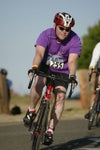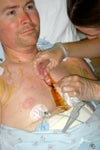New perk! Get after it with local recommendations just for you. Discover nearby events, routes out your door, and hidden gems when you sign up for the Local Running Drop.

The Ironman World Championships in Kona, Hawaii features 1,800 athletes, all of whom experienced their own journeys on the way to the start line at Kailua Bay. Kyle Garlett’s journey includes a lifetime of health issues and a heart transplant. Here is his story.
Kyle Garlett has always loved sports, but he doesn’t exactly consider himself athletic. “I played sports, but to call myself an athlete would be a disservice to all the people who are athletes,” said the 37-year-old resident of Marina Del Rey, Calif. “I played soccer, but I was the goalie. I played baseball, but I was the catcher. With any sport, I played the position that requires the least amount of running and speed.”
That’s one reason that Garlett’s goal of completing the Ironman World Championships in Kona seems unlikely. But when you add that he’s a four-time cancer survivor, has two artificial joints (a hip and a shoulder), has received a bone marrow transplant and a heart transplant, finishing the top endurance race in the world seems downright improbable. So why Kona?
“Because it’s the Big Daddy,” he said. “I’m such an unlikely person. Physically, for so long I couldn’t think about doing anything like this, and now it’s a possibility.” If he finishes, he’ll be the first heart transplant recipient to finish an Ironman.
Garlett trains six days a week with coaching from the Leukemia and Lyphoma Society’s Team in Training, and his workout fits around his career as an author and motivational speaker. So far, he’s written two books, both about sports and neither having to do with triathlon. He feels lucky to have a flexible job so that he still has time to work out and make it to doctor appointments.
“I don’t think he knows how deep he’s in for this,” said his Team in Training coach Paul Ruggiero. “But he continues to amaze me. He faces every challenge with so much determination.”

Garlett decided several years ago—before his heart transplant—that he wanted to do a triathlon once he was physically able. He remembers sitting in his hospital bed in 2006 while recovering from the transplant as he and his wife looked over the triathlon schedule to determine in which race he could realistically race.
His first race was the Malibu Triathlon less than a year later, and his wife participated, too. Part of his motivation to continue training for Kona comes from his wife. “It’s a whole lot easier to get up at 5:30 in the morning if the person next to you is getting up, too,” he said.
Since then, Garlett has competed in the Lavaman Triathlon twice and the U.S. Transplant Games. He attempted to race the Vineman 70.3 in July in Sonoma County, Calif., but he had to drop out during the run because of the heat. Garlett participated in the Utah Half Ironman on Aug. 15 as preparation for the world championship race. Kona will be his first attempt at a full Ironman.
“I’m terrified,” he said. “I’m also excited, anxious and scared. I think it’s healthy to have a series of emotions. This is a once-in-a-lifetime opportunity.”
Garlett’s health battles began during his senior year of high school. In 1989, at age 18, he was diagnosed as having Hodgkin’s disease and received five months of radiation therapy. The cancer recurred in his freshman year of college while he was studying journalism at the University of Missouri. And with the cancer came six months of chemotherapy. An allergic reaction to one of the chemo drugs affected his lungs and brought him close to death.
Three years later, in 1994, the cancer was back again. This time, doctors at City of Hope cancer center in Duarte, Calif., decided that the next step was more intense chemotherapy followed by a stem-cell transplant. Each cycle of infusion, isolation and resurrection took about a month, and Garlett went through it three times. Right before the fourth time, doctors diagnosed cardiomyopathy, a weakening of the heart muscle caused by one of the chemo drugs.
In 1997, doctors diagnosed acute lymphocytic leukemia, a secondary cancer caused by his treatment. He went through three years of chemotherapy treatment that wouldn’t further weaken his heart. In 2000, he had his right hip and left shoulder replaced because of the damage they had sustained from treatment. In 2001, he was placed on the heart transplant list at UCLA Medical Center and given a pacemaker. On Oct. 10, 2006, Garlett found out that a donor heart was ready, and by 1:30 the next morning, he was out of surgery and recovering in the ICU.
Garlett said that what got him through the cancer battles was partly support from his family and network of friends, but it was mostly his attitude. “If you go into it and treat it like you’ve gotten a raw deal, it’s hard to get through. You’re miserable and constantly complaining,” he said. “But the way I saw it was, people get cancer. People get diagnosed with cancer all the time. Why am I special? It’s like you get thrown into the water, and you have to swim or sink. You only have two choices. I chose to swim.”
His attitude toward cancer is similar to the mindset in triathlon, he said. “You can’t think, ‘I have 18 months of chemo.’ You have to think, ‘I have chemo today, and then I’m going to enjoy the rest of the day. And then I’ll have chemo tomorrow, but I’m not going to worry about that until tomorrow,’” Garlett said. And, as with triathlon, “You have to stay in the moment—to only worry about what you’re doing right then. If you’re on the bike, you can’t be thinking about having to run after the bike. You have to stay focused on the bike.”
Now, three years to the day after receiving a phone call that he was going to get a new heart, Garlett will attempt to complete the Ford Ironman World Championships in Kona. Dr. Jon Kobashigawa, medical director of UCLA’s heart transplant program, believes Garlett is an inspiration to all heart transplant recipients. Heart transplant patients don’t have nerves to their donor hearts because they have been severed for the operation, meaning that their exercise capacity is lowered. “Kyle has shown that exercise training can improve the function of the donor heart,” Kobashigawa said. “He certainly serves as a role model for all heart transplant recipients to return to an excellent quality of life.”
To be able to compete in Kona, triathletes have to either qualify through other Ironman races or be selected in the lottery. The third way to get in, though, is to be invited by the World Triathlon Corp. That method is usually reserved for the people who will make inspirational stories by participating in the race, such as Jeff Glasbrenner, a below-the-knee amputee who participated in last year’s race, or Dick and Rick Hoyt, the father-son duo in which Dick finishes Ironmans while pulling or pushing his son Rick, who can’t walk or talk.
Ruggiero, the coach, believes that it is possible for Garlett to finish Kona. “This is huge and ambitious,” he said, “and there’s not a lot of room for error. If everything goes according to plan, he’s got a really good shot.”
Garlett has been working on his third book, to be titled A Rain Will Come, for a few years. The book will be about his life and Ironman quest, and the title reflects the metaphor for rain in everyone’s life as well as the optimism with which he faces every challenge. “At some point for everyone, the sunny skies will leave and the rainstorm will roll in. But as much as we hate the clouds and prefer the sun, it’s the rain that gives us life. After a rainstorm everything is greener, more alive,” he said. “For everyone, a rain will come. So when it does, we should try and focus on the beautiful world that will take its place when it finally leaves.”
Even if Garlett doesn’t finish Kona this year, he plans to publish the book. And he may take another shot at Kona in the future. “As much as I want to finish that race, it isn’t the story. The journey from original diagnosis 20 years ago to the starting line in Kona is really the story,” he said. “Finishing would just be the cherry on top.”
To find out more about Kyle Garlett and his Ironman quest, visit Ironmankyle.com.